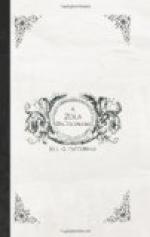It may be useful to note here that though Zola states in L’Assommoir that Gervaise and Lantier had two sons (Claude, born 1842, and Etienne, born 1846), he makes a third son (Jacques, born 1844), not elsewhere mentioned, the hero of La Bete Humaine, a subsequent work in the Rougon-Macquart series.
L’Oeuvre.
A novel dealing with artistic life in Paris towards the close of the Second Empire.
Claude Lantier, the eldest son of Auguste Lantier and Gervaise Macquart (La Fortune des Rougon and L’Assommoir), had been educated at Plassans by an old gentleman who was interested in his childish skill in drawing. His benefactor died, leaving him a sum which yielded an annual income of a thousand francs, and he came to Paris to follow an artistic career. There he met Dubuche, Pierre Sandoz, and others of his former schoolboy friends, and the little band formed a coterie of revolutionary spirits, whose aim was to introduce new ideas and drastic changes into the accepted canons of art. Claude attempted to embody his theories in a picture which he called Plein Air ("Open Air”) in which he went direct to nature for inspiration, and threw aside all recognized conventions. The picture was refused by the committee of the Salon, and when subsequently shown at a minor exhibition was greeted with derision by the public. The artist was in despair, and left Paris with Christine Hallegrain, a young girl between whom and himself a chance acquaintanceship had ripened into love. They lived happily in a little cottage in the country for several years, a son being born to them, but Claude became restless, and they returned to Paris. Here he gradually




